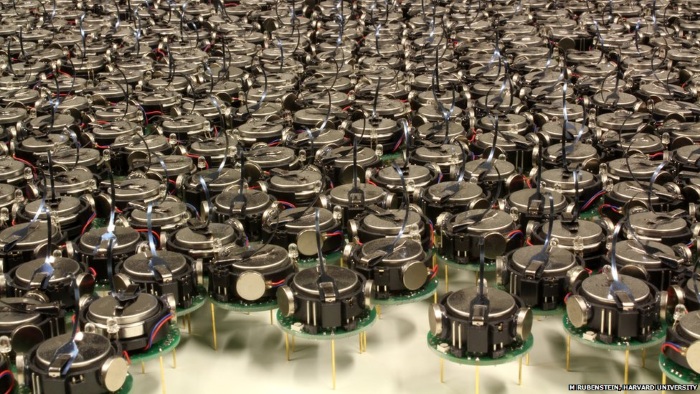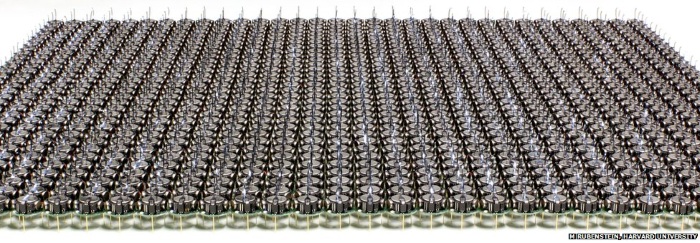While the demonstration of 1,000 robots shuffling into order to form a specific shape is visually impressive, the actual purpose behind this little parade is to demonstrate the technology’s capability of one day being able to provide users with self-assembling tools and structures.

What’s interesting is that the technology’s framework is actually based around various biological examples, including cells forming organs as well as ants building bridges.
“Each robot is identical and we give them all the exact same program,” said Dr. Michael Rubenstein, the first author of the study, which is published in Science. “The only thing they have to go on, to make decisions, is what their neighbors are doing.”
The robots measure 3cm across and are cylindrical in shape. According to Dr. Rubenstein and his colleagues at Harvard University, the bots are referred to as “Kilobots” and a total of 1,024 were built altogether—the same as the number of bytes in a kilobyte.

Each Kilobot gets around on three straight, spindly legs, which were chosen specifically for the fact that they are cheaper than wheels. At the start of the experiment, the group of bots are bunched up together on one side. Above them hangs an infrared light which communicates with the swarm vis-à-vis an infrared sensor built into the underside of each Kilobot.
The light sends one command and one command only: “Go”.

The way the Kilobots co-ordinate is interesting — four “seed” robots are specially placed within the group, and they are tasked with organizing the other bots into a shape. They send messages to their nearby neighbors via the infrared lights, which spread throughout the group and can be heard by any bot within a radius of 10cm.
“Each robot looks at its current state — so, what have I done in the past — and also looks at what its neighbors are doing, based on communication. And it makes its own decisions,” Dr. Rubenstein explained to the BBC. “Running this identical program, all the robots are capable of taking turns to join the shape.”
It should be noted that it takes the robots approximately 12 hours to form the shape, but this is by far the largest group of robots ever built and studied in this manner. The reason why it takes so long is because the Kilobots are very simple in their design, and these limited capabilities lead to mistakes that need to be corrected during the course of the group taking shape.
Dr. Rubenstein described the process of watching them swarm together to take shape, which ranged anywhere from six to 12 hours, as being akin to “watching paint dry”.
Regardless, there’s been considerable interest in the technology since it was first revealed at a conference in 2012. The code governing the bots is open-source and so is under a constant state of update, and a company is already set up selling the robots for approximately $100 each.
To see a fast-forward clip of the 1,000 Kilobots in action, check out the video below:
Story via bbc.com
Advertisement
Learn more about Electronic Products Magazine





